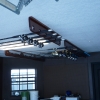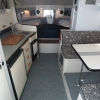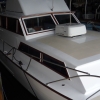A Boatwright can be defined as a craftsman that builds wooden boats. Organizations like The Chris-Craft Antique Boat Club exist to help keep alive both the skills and the boats themselves as wood becomes a thing of the past for use in their construction. Having owned, lived and worked as captain and crew on steel, fiberglass, aluminum and wooden vessels, I can speak of the pros and cons of owning these various types. The purpose of having the boat will be limited in this essay to pleasure craft.
In this section, I’ll talk in general about wood boats ranging in size from about thirty to fifty feet in length. There is virtually no question that these boats will ride more comfortably than their other hull material alternatives. Marguerite and I lived and cruised aboard a classic forty eight foot 1957 Bullnose Chris-Craft Constellation for years. We traveled from New York to Texas and back. It was roomy and comfortable.
Once a wooden vessel achieves the state of maintenance only, the work required for that maintenance is about the same, but sometimes less than boats built from other materials. Ever dealt with blisters? Because of the growing scarcity of old time yachts, restoring, refurbishing and updating are where older skill sets are progressively more difficult to find.
Attention to specific wood for specific structures that make up the vessel is very important. As I write this, the new owner of an old boat next to the one I’m working on is using treated lumber, non-marine ply and steel fasteners. The work required to make repairs is the same regardless of materials. The increased cost by using proper materials will be nothing compared to the cost of redoing all the work next year.
Pretty much nothing is square in a boat. For wood, this means having the right tools and skills to use them. Various planes, sanders, saws and bits are essential for repairing and restoring wood vessels that are not needed on other types. Properly treating the wood with a penetrating epoxy for both original and new wood will extend the life years beyond doing the same work without this treatment. Using the primer and paint developed for wood can make or break the job. I know one guy who uses Awlgrip on his hull. Every year or so, he replaces rotten planks because Awlgrip, as good as it can look, prevents the wood from breathing so it ends up rotting because the water is trapped by the paint.
How often do you see advertisements for old wood boats boasting that they lived their life in fresh water, as though that were a good thing. Salt water preserves the wood. Fresh water encourages the growth of various types of fungus which begins the destructive process wreaked upon fibrous cells. This in turn makes the wood more attractive to tiny bugs that burrow and sometimes eat the wood. That’s why you see the topsides of many wood boats in bad shape. It’s from the rain water. One reason people think fresh water is great for wood boats is because there are no hull destroying worms in fresh water. Worm destruction is easily avoided in salt water by using proper bottom paint and worm shoes. One trick I’ve seen with some owners has them cruising up rivers where the fresh water kills any existing worms.
In the future, we will address more specific areas of work with wood on boats.




